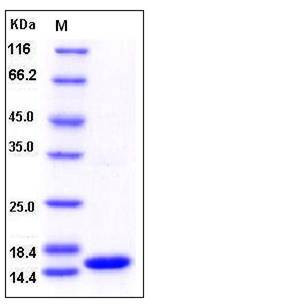Human FABP5 / E-FABP Protein
E-FABP,EFABP,KFABP,PA-FABP,PAFABP
- 100ug (NPP3854) Please inquiry
| Catalog Number | P12581-HNAE |
|---|---|
| Organism Species | Human |
| Host | E. coli |
| Synonyms | E-FABP,EFABP,KFABP,PA-FABP,PAFABP |
| Molecular Weight | The recombinant human FABP5 consisting of 135 amino acids and has a calculated molecular mass of 15.2 kDa as estimated in SDS-PAGE under reducing conditions. |
| predicted N | Met 1 |
| SDS-PAGE |  |
| Purity | > 92 % as determined by SDS-PAGE |
| Protein Construction | A DNA sequence encoding the human FABP5 (Q01469) (Met 1-Glu 135) was expressed and purified. |
| Bio-activity | |
| Research Area | Developmental Biology |Metabolism |Pathways and Processes |Metabolic signaling pathways |Lipid and lipoprotein metabolism |Fatty acids | |
| Formulation | Lyophilized from sterile 50mM Tris, pH 8.0 1. Normally 5 % - 8 % trehalose and mannitol are added as protectants before lyophilization. Specific concentrations are included in the hardcopy of COA. |
| Background | Fatty acid-binding protein, also known as Epidermal-type fatty acid-binding protein, Fatty acid-binding protein 5, Psoriasis-associated fatty acid-binding protein homolog, E-FABP and FABP5, is a cytoplasm protein which Belongs to the calycin superfamily and Fatty-acid binding protein (FABP) family. Fatty acid-binding proteins ( FABPs ) are postulated to serve as lipid shuttles that solubilize hydrophobic fatty acids and deliver them to appropriate intracellular sites. E-FABP / FABP5 is predominantly expressed in keratinocytes and is overexpressed in the actively proliferating tissue characteristic of psoriasis and wound healing. E-FABP / FABP5 exhibits an important role in binding free fatty acids, as well as regulating lipid metabolism and transport. E-FABP / FABP5 has high specificity for fatty acids. It has highest affinity for C18 chain length. Decreasing the chain length or introducing double bonds reduces the affinity of FABP5. E-FABP / FABP5 may be involved in keratinocyte differentiation. |
| Reference |
